Recently, we've seen helium being used for two things, namely cooling and storage, and it is the latter use that Seagate does not hold much faith in, despite the apparent enthusiasm of Western Digital, more specifically its subdivision HGST (Formerly Hitachi Global Storage Technologies).
The idea of using helium instead of air in hard drives is one that HGST advocates, and which has already spawned hard disks with seven platters.
The main advantage of this method lies in the fact that helium, being of a lower density than air, provides a lower drag force and, thus, reduces the power needs of the motors in an HDD.
More efficient thermal conduction and decreased shear force (consequently, less noise) are extra benefits.
Seagate doesn't think they are worth it though. This “sealed-drive” technology presumably carries too many risks.
One might be tempted to call this being a bad sport, but that argument doesn't have weight when Seagate also has a history in helium-filled HDD development. The company even has 80 patents in the field.
Seagate admits that helium can solve a number of problems, but it also creates new ones, like leak prevention, or higher manufacturing and material costs.
Overall, the company believes that inventing new methods of magnetic recording is more practical, since it will benefit all sorts of HDDs and won't come at any extra cost to buyers.
"We have explored helium filled drives ('sealed drive' technology) as well as many other technologies for delivering higher capacities and lower TCO,” Jon Piazza, senior manager of corporate communications at Seagate, told X-bit labs.
“Helium can solve some internal technical challenges, but it also creates new challenges, like how to prevent leaks and bring down manufacturing and materials costs. Fortunately, we have been able to advance our drive technology and capacities without resorting to filling our drives with helium.”
Mr. Piazza calls attention to HAMR, heat-assisted magnetic recording, believing it to be a better path. The 60 TB storage potential is definitely something to think about.

 14 DAY TRIAL //
14 DAY TRIAL //